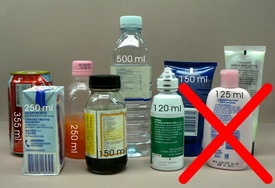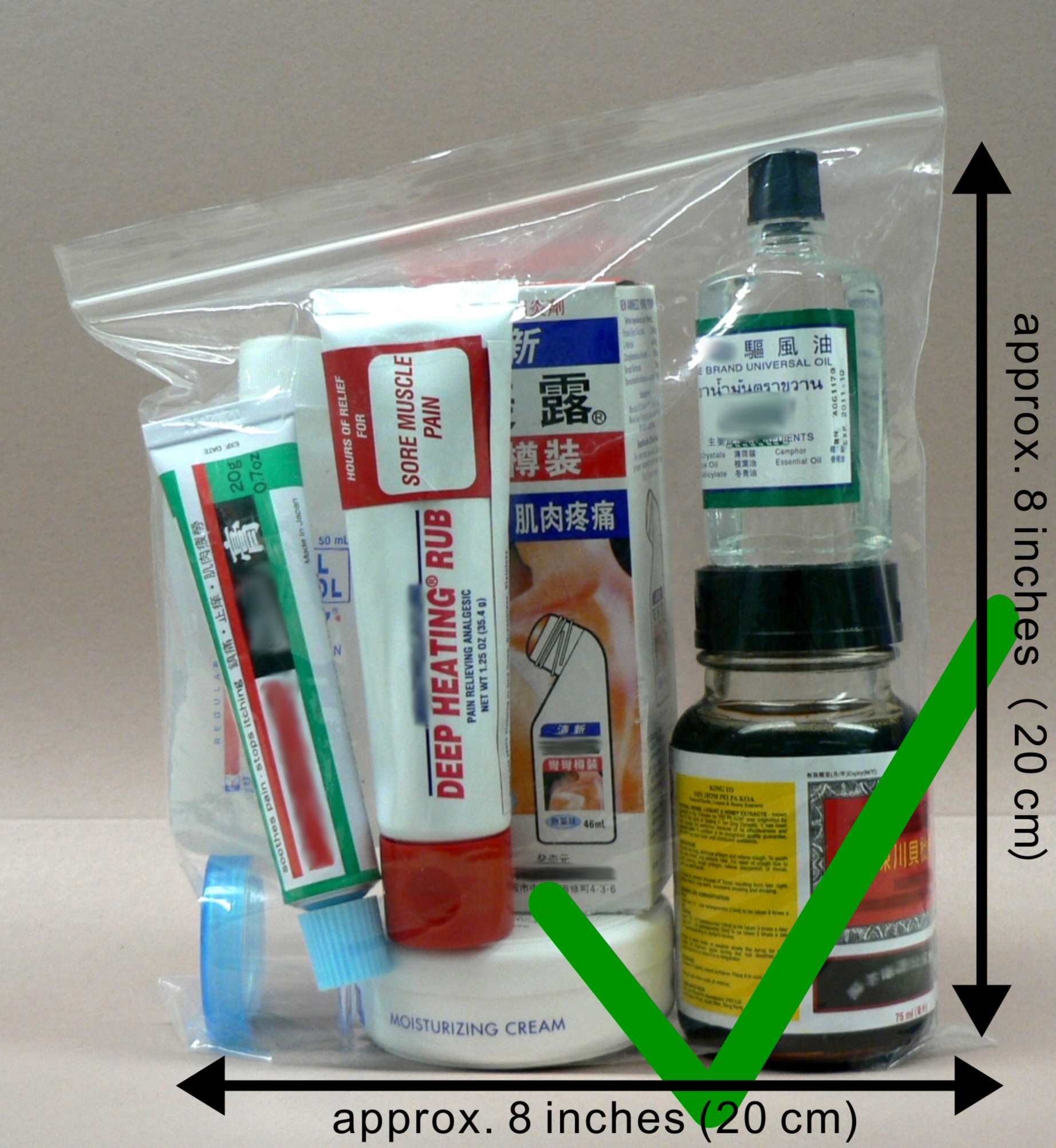Packing Tips for Air Passengers
- Baggage Allowance
- Security Restricted Articles
- Restrictions on carriage of Liquids, Gels, Aerosols (LAG) in cabin
baggage
- Restrictions on Dangerous Goods
- Carriage of Portable Electronic Devices (PEDs) Containing Lithium
Batteries
- Damaged, defective or recalled lithium batteries or devices
- Smart Luggage
- Baggage Allowance
Please contact your airline concerned direct for details.
- Security Restricted Articles
The following security restricted articles are prohibited from carriage as hold baggage and cabin baggage.
Apart from the restrictions on carriage of baggage as shown on this page, air passengers shall also observe other requirements relating to the possession of restricted items, such as stun gun, within the territory of Hong Kong. For details please visit the Hong Kong Police Force's webpage: Advice to Visitors.
A. Security Restricted Articles - Hold Baggage
Explosive or incendiary substances, devices or articles capable of being used to cause serious injury or threatening the safety of the aircraft including:
- *ammunition;
- blasting caps;
- detonators and fuses;
- mines, grenades and other explosive military stores;
- pyrotechnics, including fireworks;
- smoke-generating canisters or cartridges; and
- dynamite, gunpowder and plastic explosives
*If the possession of such ammunition (in Hong Kong) by a passenger is lawful, he/she may make arrangements with his/her airline for its transportation as hold baggage on a flight from Hong Kong. The handling of such are strictly in accordance with the requirements of the Air Navigation (Hong Kong) Order 1995 and under conditions specified in the Technical Instructions for the Safe Transport of Dangerous Goods by Air (Doc 9284).
B. Security Restricted Articles - Cabin Baggage
Category 1 - Explosives and incendiary substances and other components
Explosives and incendiary substances and other components such as detonators, ignitors and secondary items such as incendiary material devices capable of being used to cause serious injury or threatening the safety of the aircraft, including:
- ammunition;
- blasting caps;
- detonators and fuses;
- replica or imitation explosive devices;
- mines, grenades and other explosive military stores;
- pyrotechnics including fireworks, party poppers, toy caps;
- smoke-generating canisters or cartridges; and
- dynamite, gunpowder and plastic explosives.
Category 2 - Guns, firearms and stunning devices
Guns, firearms and other devices designed to cause serious injury or capable of being mistaken for such devices, including components of firearms and ammunition, and weapons such as 3D printed items. Those include:
- firearms of all types, including pistols, revolvers, rifles, shotguns;
- toy guns, replicas and imitation firearms capable of being mistaken for real weapons, such as gun lighters;
- component parts of firearms, excluding telescopic sights;
- compressed gas guns, including pistols, pellet guns, rifles and ball bearing guns;
- signal flare pistols and starter pistols; and
- stun devices and improvised devices such as devices for shocking including but not limited to stun guns and stun batons, and animal stunners and animal killers.
Category 3 - Chemical substances
Chemical substances, such as:
- disabling and incapacitating chemicals, gases and sprays, such as mace, pepper or capsicum spray, acid sprays, animal repellent sprays, and tear gas;
- chemicals that, when mixed, are capable of creating a hazard through reaction (hypergolic reactions); and
- chemicals that may cause any hazard to life or property.
Category 4 - Objects with sharp points or sharp edges, and devices that discharge projectiles
Objects with sharp points or sharp edges, and devices that discharge projectiles capable of being used to cause serious injury, including:
- items designed for chopping, such as axes, hatchets and cleavers;
- ice axes and ice picks;
- ice skates;
- razor blades, open razors (except safety or disposable razors with blades enclosed in cartridge), utility knives and box cutters;
- bows, cross bows and arrows;
- harpoon guns and spear guns;
- slingshots and catapults;
- lockable or flick knives with blades of any length;
- knives, with blades of any length, made of metal or any other material strong enough to be used as a potential weapon (except knives with round-ended blunt tip);
- scissors with blades of more than 6 cm as measured from the fulcrum;
- martial arts equipment with sharp points or sharp edges;
- swords and sabres;
- darts; and
- ski poles.
Category 5 - Workers’ tools
Workers’ tools capable of being used either to cause serious injury or to threaten the safety of aircraft, including:
- crowbars;
- drills and drill bits, including cordless portable power drills;
- tools with blades or shafts more than 6 cm capable of use as weapons, such as screwdrivers and chisels;
- saws, including cordless portable power saws;
- blowtorches;
- bolt guns and nail guns;
- hammers;
- pliers; and
- wrenches / spanners.
Category 6 - Blunt instruments
Blunt instruments capable of being used to cause serious injury when used to hit, including:
- baseball and softball bats;
- billiard and pool cues;
- cricket bats, hockey sticks and lacrosse sticks;
- golf clubs;
- clubs and batons, such as billy clubs, blackjacks and night sticks; and
- martial arts equipment, including knuckledusters, clubs, coshes, rice flails, nunchaku, kubotans, kubasaunts.
Please note the examples on the above list are not exhaustive in nature. Some airlines and destination / transit countries may also have additional requirements on carriage of security restricted items by passengers. Passengers are advised to contact relevant airline and authorities for further details and assistance.
- Restrictions on carriage of Liquids, Gels, Aerosols (LAG) in cabin baggage
The Hong Kong International Airport (HKIA) has implemented security measures for screening liquids, gels and aerosol starting from March 21, 2007 to comply with the guidelines of the International Civil Aviation Organisation.
The security measures for cabin baggage at HKIA include:
-
All liquids, gels, aerosols in cabin baggage have to be carried in containers with a
capacity not greater than 100 ml. Liquids, gels, aerosols carried in containers larger than
100 ml will not be accepted, even if the container is only part-filled.


-
Containers have to be placed in a transparent re-sealable plastic bag of a maximum capacity
not exceeding one litre. The containers must fit comfortably within the transparent plastic
bag, which should be completely closed.


-
The plastic bag has to be presented separately from other cabin baggage for visual
examination at the screening point. Only one transparent plastic bag per passenger is
permitted.

- Exemptions will be made for medications, baby milk / food and special dietary requirements subject to verification.
For frequently asked questions regarding the restrictions on the carriage of liquids, gels and aerosols cabin baggage, please click here.
- Restrictions on Dangerous Goods
Dangerous Goods are articles or substances which are capable of posing a hazard to health, safety, property or the environment when transported by air. The International Civil Aviation Organization (ICAO) classified dangerous goods in 9 classes, which are:
| Class 1 | Explosives |
| Class 2 | Gases |
| Class 3 | Flammable liquids |
| Class 4 | Flammable solids; substances liable to spontaneous combustion; substances which, in contact with water, emit flammable gases |
| Class 5 | Oxidizing substances and organic peroxides |
| Class 6 | Toxic and infectious substances |
| Class 7 | Radioactive material |
| Class 8 | Corrosive substances |
| Class 9 | Miscellaneous dangerous substances and articles |
As a passenger, it is an offence under the Air Navigation (Hong Kong) Order 1995 (Cap.448C) to take dangerous goods (except for certain dangerous goods in very small quantity and in special condition) on board an aircraft. The law restricts the type and quantity of dangerous goods allowed to be carried by passengers, because they can be a danger to you and the aircraft in flight due to temperature and pressure difference.
For more details regarding the provisions for dangerous goods carried by air passengers, please click here.
- Carriage of Portable Electronic Devices (PEDs) Containing Lithium Batteries
If PEDs containing lithium batteries (such as laptop / tablet computer) are carried in checked baggage:
- measures must be taken to prevent unintentional activation and to protect the devices from damage; and
- the devices must be completely switched off (not in sleep or hibernation mode)
- Damaged, defective or recalled lithium batteries or devices
To ensure aviation safety, passengers are reminded not to transport on aircraft any lithium batteries or devices containing such batteries, which are damaged, identified to be defective, or recalled by manufacturer for safety reasons due to potential fire hazard.
- Smart Luggage
Please refer to Section (I) of Packing Tips for Air Passenger (PDF: 421KB) for guidance on smart luggage with lithium batteries.

